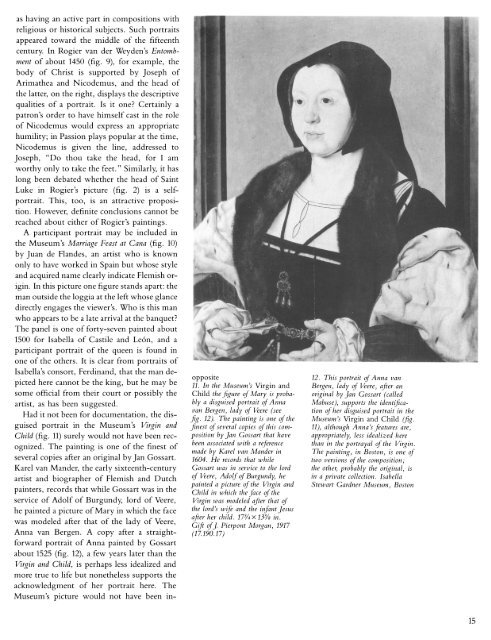Early Flemish Portraits 1425-1525: The Metropolitan Museum of Art ...
Early Flemish Portraits 1425-1525: The Metropolitan Museum of Art ...
Early Flemish Portraits 1425-1525: The Metropolitan Museum of Art ...
Create successful ePaper yourself
Turn your PDF publications into a flip-book with our unique Google optimized e-Paper software.
as having an active part in compositions with<br />
religious or historical subjects. Such portraits<br />
appeared toward the middle <strong>of</strong> the fifteenth<br />
century. In Rogier van der Weyden's Entombment<br />
<strong>of</strong> about 1450 (fig. 9), for example, the<br />
body <strong>of</strong> Christ is supported by Joseph <strong>of</strong><br />
Arimathea and Nicodemus, and the head <strong>of</strong><br />
the latter, on the right, displays the descriptive<br />
qualities <strong>of</strong> a portrait. Is it one Certainly a<br />
patron's order to have himself cast in the role<br />
<strong>of</strong> Nicodemus would express an appropriate<br />
humility; in Passion plays popular at the time,<br />
Nicodemus is given the line, addressed to<br />
Joseph, "Do thou take the head, for I am<br />
worthy only to take the feet." Similarly, it has<br />
long been debated whether the head <strong>of</strong> Saint<br />
Luke in Rogier's picture (fig. 2) is a self-<br />
portrait. This, too, is an attractive proposition.<br />
However, definite conclusions cannot be<br />
reached about either <strong>of</strong> Rogier's paintings.<br />
A participant portrait may be included in<br />
the <strong>Museum</strong>'s Marriage Feast at Cana (fig. 10)<br />
by Juan de Flandes, an artist who is known<br />
only to have worked in Spain but whose style<br />
and acquired name clearly indicate <strong>Flemish</strong> origin.<br />
In this picture one figure stands apart: the<br />
man outside the loggia at the left whose glance<br />
directly engages the viewer's. Who is this man<br />
who appears to be a late arrival at the banquet<br />
<strong>The</strong> panel is one <strong>of</strong> forty-seven painted about<br />
1500 for Isabella <strong>of</strong> Castile and Le6n, and a<br />
participant portrait <strong>of</strong> the queen is found in<br />
one <strong>of</strong> the others. It is clear from portraits <strong>of</strong><br />
Isabella's consort, Ferdinand, that the man depicted<br />
here cannot be the king, but he may be<br />
some <strong>of</strong>ficial from their court or possibly the<br />
artist, as has been suggested.<br />
Had it not been for documentation, the disguised<br />
portrait in the <strong>Museum</strong>'s Virgin and<br />
Child (fig. 11) surely would not have been recognized.<br />
<strong>The</strong> painting is one <strong>of</strong> the finest <strong>of</strong><br />
several copies after an original by Jan Gossart.<br />
Karel van Mander, the early sixteenth-century<br />
artist and biographer <strong>of</strong> <strong>Flemish</strong> and Dutch<br />
painters, records that while Gossart was in the<br />
service <strong>of</strong> Adolf <strong>of</strong> Burgundy, lord <strong>of</strong> Veere,<br />
he painted a picture <strong>of</strong> Mary in which the face<br />
was modeled after that <strong>of</strong> the lady <strong>of</strong> Veere,<br />
Anna van Bergen. A copy after a straightforward<br />
portrait <strong>of</strong> Anna painted by Gossart<br />
about <strong>1525</strong> (fig. 12), a few years later than the<br />
Virgin and Child, is perhaps less idealized and<br />
more true to life but nonetheless supports the<br />
acknowledgment <strong>of</strong> her portrait here. <strong>The</strong><br />
<strong>Museum</strong>'s picture would not have been in-<br />
opposite<br />
11. In the <strong>Museum</strong>'s Virgin and<br />
Child the figure <strong>of</strong> Mary is probably<br />
a disguised portrait <strong>of</strong> Anna<br />
van Bergen, lady <strong>of</strong> Veere (see<br />
fig. 12). <strong>The</strong> painting is one <strong>of</strong> the<br />
finest <strong>of</strong> several copies <strong>of</strong> this composition<br />
by Jan Gossart that have<br />
been associated with a reference<br />
made by Karel van Mander in<br />
1604. He records that while<br />
Gossart was in service to the lord<br />
<strong>of</strong> Veere, Adolf <strong>of</strong> Burgundy, he<br />
painted a picture <strong>of</strong> the Virgin and<br />
Child in which the face <strong>of</strong> the<br />
Virgin was modeled after that <strong>of</strong><br />
the lord's wife and the infantJesus<br />
after her child. 173/4 x 1358 in.<br />
Gift <strong>of</strong>J. Pierpont Morgan, 1917<br />
(17.190.17)<br />
12. This portrait <strong>of</strong> Anna van<br />
Bergen, lady <strong>of</strong> Veere, after an<br />
original by Jan Gossart (called<br />
Mabuse), supports the identification<br />
<strong>of</strong> her disguised portrait in the<br />
<strong>Museum</strong>'s Virgin and Child (fig.<br />
11), although Anna's features are,<br />
appropriately, less idealized here<br />
than in the portrayal <strong>of</strong> the Virgin.<br />
<strong>The</strong> painting, in Boston, is one <strong>of</strong><br />
two versions <strong>of</strong> the composition;<br />
the other, probably the original, is<br />
in a private collection. Isabella<br />
Stewart Gardner <strong>Museum</strong>, Boston<br />
15

















